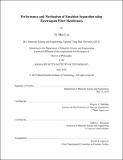Performance and mechanism of emulsion separation using electrospun fiber membranes
Author(s)
Lin, Yi-Min,Ph.D.Massachusetts Institute of Technology.
Download1128817770-MIT.pdf (12.02Mb)
Other Contributors
Massachusetts Institute of Technology. Department of Materials Science and Engineering.
Advisor
Gregory C. Rutledge.
Terms of use
Metadata
Show full item recordAbstract
The compositions of oil-in-water emulsions encountered in industrial processes vary widely depending on their sources. This variety creates challenges for the application of membrane-based separation. Electrospun fiber membranes have gained attentions in emulsion separation due to their high porosity and open, highly interconnected pore structure. However, because of the unique fibrous structure of the membrane and the deformability of oil droplets, the fouling mechanism in filtration process remains unclear. To study the membrane-emulsion interaction, electrospun polyamide membranes were challenged by model emulsions of dodecane stabilized by different types of surfactants in dead-end and cross-flow configurations. It was found fouling in dead-end filtration was mainly determined by the electrostatic interactions between the membrane and the foulants, while the fouling in cross-flow filtration was correlated to the hydrophobic interactions between the oil drop and the membrane. These findings were corroborated by the classical blocking filtration models and in-situ visualization by camera. Blocking filtration models also illustrated the transition of fouling modes in dead-end filtration. Based on the findings, a membrane design strategy to reduce membrane fouling in microfiltration of oily emulsions was developed by inducing electrostatic repulsions between the membrane and emulsion. Plasma treatment and successive layer-by-layer polyelectrolyte dipping depositions were used to alter the surface charge of electrospun polyamide membranes while maintaining the interconnected pore structure and high porosity. The permeate flux of the plasma-treated membranes when separating emulsions stabilized by anionic surfactants were reported to increase ~3.2-fold, compared to that of the as-electrospun membranes, after 4 hours of cross-flow filtration. When separating emulsions stabilized by cationic surfactants, the permeate flux of the polycation-coated membraned similarly increased ~3.3-fold. This anti-fouling tendency can be expressed quantitatively as a function of a proposed design metric, electrostatic repulsion strength. To investigate the fouling mechanism and oil drop-fiber interaction, direct, three-dimensional (3D) visualization of oil-fouled electrospun fiber membranes are reported for the first time in this thesis. High-resolution 3D images were acquired by a dual-channel confocal laser scanning microscopy (CLSM) in which both the fibers and the oil were fluorescently labeled. Through direct visualization, rejected oil is found to form droplets of clam-shell shape on the oleophobic fibers, while the oil tend to wet the oleophilic polymeric fibers and spread across the membrane. The morphology of oily foulants is also analyzed as a function of separation time, which is qualitatively consistent with the transition of fouling modes indicated by the blocking filtration models. This direct, 3D visualization CLSM technique is a powerful tool for characterizing the mechanisms of fouling in membranes used for liquid emulsion separations.
Description
This electronic version was submitted by the student author. The certified thesis is available in the Institute Archives and Special Collections. Thesis: Ph. D., Massachusetts Institute of Technology, Department of Materials Science and Engineering, 2019 Cataloged from student-submitted PDF version of thesis. Includes bibliographical references.
Date issued
2019Department
Massachusetts Institute of Technology. Department of Materials Science and EngineeringPublisher
Massachusetts Institute of Technology
Keywords
Materials Science and Engineering.